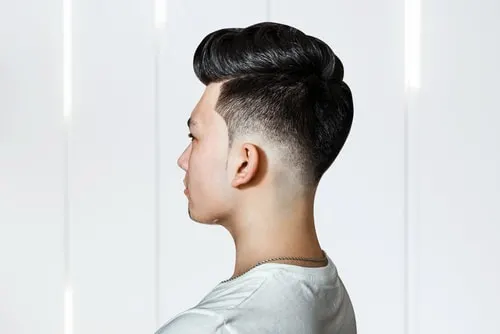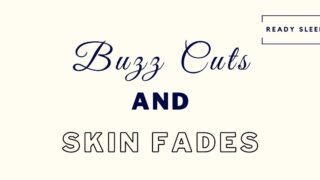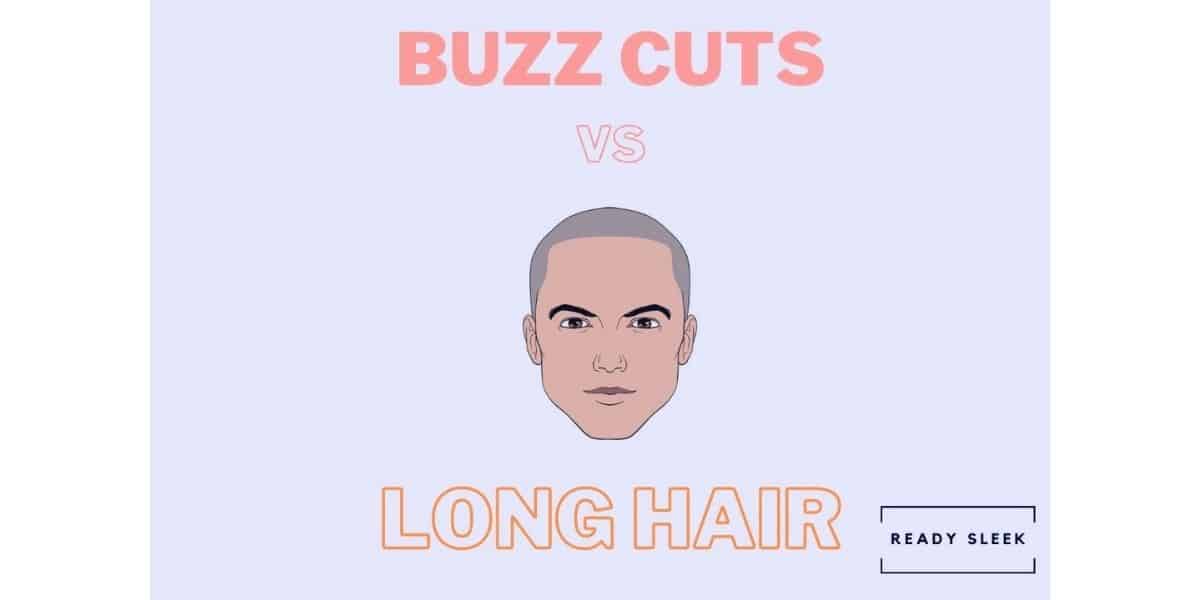The most important thing when it comes to fades is knowing what you’re asking for. There’s nothing worse than asking for a specific fade and getting something you weren’t expecting.
Here’s everything you need to know about a particularly common one – the zero fade.
Let’s get to it.
What Is A Zero Fade Haircut?
A zero fade haircut is an effect where the shortest length at the sides is clipped using the lone blade of a clipper, leaving behind short stubble. It then gradually increases in length from the bottom to the top, with the different lengths seamlessly blending into each other.

Image From Deposit Photos
Essentially, a zero fade haircut is one step longer than a skin fade.
It doesn’t require shaving – you don’t need a razor to produce it because you aren’t shaving all the way down to the skin.
A clipper with no guard attached is used to produce the short stubble at the bottom of the sides and back.
The stubble length will usually be around 0.5 and 0.8mm when you use the clipper with no guard attached – it really depends on the blade height and the clipper you’re using.
A standard Wahl blade will usually trim down to 0.8mm, while the #000 blade of an Oster or Andis clipper will trim down to approximately 0.5mm.
The lever of the clipper can be used to adjust the stubble length as well. Leaving the lever open with no guard attached will allow you to get very slightly longer stubble.
However, it won’t be as long as it would be if you were to attach a #0.5 guard or #1 guard, for instance.
The clipper is then used to gradually increase the length in small increments, going up from the #0 length at the bottom. For example, from a zero at the bottom to a #0.5, #1, and then a #2 at the top of the sides.
The characteristic “fade” effect is produced because the lengths blend into each other with no harsh lines. That blurred and faded effect is eye-catching.
Zero fades vary according to how high up the sides and back they are.
They can be “low”, “mid”, or “high”, depending on how high up the sides the zero length reaches before it transitions into longer lengths.
Let’s discuss these “fade heights” in more detail.
Low Zero Fade
A low zero fade is where the zero length (0.5mm – 0.8mm) at the bottom of the sides starts to blend and transition into longer lengths approximately half an inch above the ear.

A simpler way of saying it would be that the fade sits low on the sides and back.
It’s a subtle form of a zero fade, simply because only a small portion of the sides and back is trimmed down to the shortest length – the zero length.
As a result, a low zero fade isn’t as obvious or noticeable as mid fades and high fades, for instance.
It’s a good option for men who want a very short fade at the sides but don’t want it to have too much prominence within their overall hairstyle.
Low fades work well when it comes to that.
A “zero fade taper” is essentially a very low zero fade. The transition from the zero length at the bottom into longer lengths further up the sides occurs around the top of the sideburns.
As a result, zero fade tapers are about as subtle as you can get when it comes to zero fades.
If you want a zero fade that’s noticeable but really just a minor feature of your overall style, a taper may be a good way to go.
Mid Zero Fade
A mid zero fade is where the #0 length (0.5mm – 0.8mm) at the bottom of the sides starts to transition into longer lengths approximately one inch above the ear.

Usually, this results in the zero length starting to blend into longer lengths approximately halfway up the sides.
The exact height at which this occurs obviously depends on the individual’s head size.
But overall, the “one inch above the ear” guide is a pretty safe bet.
What this leads to is around half of the sides and back being at the shortest length – the very short stubble of the zero length.
Although this isn’t quite as short as a skin fade, it’s still super short.
Because of this, mid zero fades are pretty attention-grabbing and eye-catching. They aren’t as subtle as low zero fades or zero fade tapers.
As with any other zero fades, the zero length can gradually transition into any longer length higher up – whether that’s a #1, #2, #3, or even longer.
The greater the difference in length between the zero length at the bottom and the highest length it transitions to higher up the sides, the more obvious the shortness of the zero length will look.
In addition, the greater the difference in length between the zero length at the bottom of the sides and the hair on top of the head, the more eye-catching the zero fade will look.
For example, a mid zero fade will look more prominent when combined with a pompadour up top when compared to a #2 buzz cut with a mid zero fade.
High Zero Fade
A high zero fade is where the #0 length (0.5mm – 0.8mm) at the bottom of the sides and back starts to transition and blend into longer lengths around the level of the temples.

High fades are about as high as you can get with fades.
Any higher and you’d be going into high and tight territory.
High zero fades are especially attention-grabbing because of how short the zero length really is. It’s very short stubble.
Essentially, you’re clipping down most of the sides and back of the head down to very short stubble, before blending it into longer hair around the level of the temples.
That’s pretty high up to start increasing the length – this is very noticeable.
But this eye-catching nature of the high zero fade is what makes it appealing to so many men. It’s a great way to make a statement and make a hairstyle stand out a little.
Having said that, it probably isn’t a good idea for someone going for their first ever fade. If you’re looking to try out fades, go for a lower fade or a longer fade.
For example, go for a high 2 fade instead of a high zero fade.
Alternatively, go for a low zero fade or a zero fade taper instead of a high fade.
If you’re a fan of the look after assessing the outcome for a few days, there’s no reason why you can’t go all the way to a high zero fade on your next try.
It’s important to make the distinction between a high zero fade and an undercut, as they’re often confused with each other.
An undercut is different to a high fade.
With undercuts, the transition from the sides to the top isn’t gradual like it is with a high fade. Instead, there is a harsh and sharp transition from the very short sides to the longer hair on top with no gradual blending.
In addition, with undercuts, the hair on top is often left long and often (but not always) slicked back.
With high zero fades, the sides are just as short as they are with undercuts.
But instead of transitioning harshly from the sides to the top, the zero length is gradually blending into longer lengths before it reaches the longer hair on top of the head.
Frequently Asked Questions
Here are a couple of frequently asked questions on zero fades to really round off this topic.
How Long Does A Zero Fade Last?
A zero fade will last approximately 2 weeks. At the 2-week mark, most people with a zero fade will feel they need to get it redone, although most will settle for 3-weekly cuts given the cost.
It’s no secret that fade maintenance isn’t easy, especially when you’ve got a super short fade like a zero fade.
The reason for this is that when you’re dealing with very short fades like zero fades and skin fades, the growth of even a few millimeters on top can be noticeably different to the cut you got originally.
When you’re dealing with 1 fades and 2 fades, for instance, this isn’t as big of a deal and you could potentially go a week or two longer before getting it touched up.
But if you’re looking to have a consistent zero fade at all times and will settle for nothing short of perfection, you’ll probably find that anything less than 2-weekly fades is going to fall short.
The cost of this shouldn’t be underestimated and will understandably be a serious barrier to most people looking to keep their fade looking clean at all times.
One way of making zero fades last longer is by making sure the barber you visit is experienced. Good barbers know how to fade seamlessly and to produce fades built to last.
A bad fade won’t last as long – it’s as simple as that.
Another thing you could consider is learning how to touch up fades yourself. This won’t be for everyone – it’s definitely possible to mess up a fade and this isn’t a decision you should take lightly.
But if you’re pretty confident with a pair of clippers already, touching up a zero fade may not be as hard as you think. There are online videos out there that do show you how to do it.
Having said that, the main bulk of a fade should always be done by a professional if you want the best results.
Learning how to do minor touch ups may simply just extend the time in between visits to the barber.
How Do You Ask For A Zero Fade?
When asking for a zero fade, let the barber know that you want a #0 length at the bottom of the sides and back. In addition, tell them what length you want the zero length to transition into and whether you want a low, mid, or high zero fade.
Asking for a “zero fade” should be enough to let the barber know what you want the shortest length of the fade to be.
But you also need to let them know what you want to transition it into. For example, do you want that #0 length to transition up into a #1, a #2, or a #3?
In addition, where do you want that transition to start – “low”, “mid”, or “high”?
Finally, let the barber know what you want to do with the hair on top of the head. Are you leaving it long? Is it going to be scissor cut?
The simplest way of communicating all of this to a barber would be to simply show a photograph of the fade you want.
This is the best option because a fade you may have thought was a zero fade to begin with actually isn’t.
It saves you from having any nasty surprises at the end of the cut. You’ll know exactly what you’re getting into.
Conclusion
The zero fade is a great one to get to grips with.
Now that you know what it is and what it looks like, there’s no reason you can’t ask your barber for one during your next visit if you’re a fan.
At least now you’ll know exactly what to expect.
Enjoy.
Ready Sleek founder. Obsessed with casual style and the minimalist approach to building a highly functional wardrobe. Also a fan of classic, vintage hairstyles.

![Zero Fade Haircuts: Low, Mid, And High [With Photos]](https://www.readysleek.com/wp-content/uploads/2021/10/zero-fade-haircuts-720x405.jpeg)





